Best 360 camera 2024: the finest choices for capturing every angle
The best 360 cameras for capturing everything around you

1. The list in brief
2. Best overall
3. Best stabilization
4. Best 8K
5. Best 3D VR
6. Best modular
7. Best waterproof
8. How to choose
9. How we test
With an increasing number of 360 degree cameras entering the market, it can be a challenge to decide which one is best for you. Most adopt the simple idea of combining two ultra wide-angle lenses back-to-back. The captured footage is then digitally combined into a fully spherical video or, more usefully, into a standard two-dimensional video weaved together from frames that you've chosen after the fact.
The best 360 cameras include features like automatic stitching (which saves you the hassle of manually aligning multiple captures), image stabilization, live-streaming and resolution, which in some cases goes up to 8K. It's also worth looking at cropping functionality, which allows you to extract a standard ‘flat’ video from the 360 degree footage you’ve captured. This means you can shoot everything that’s going on and select your area of focus when you're back home
With many features that go beyond simple 360 degree coverage, it's no wonder comparing like-for-like isn't the easiest. We've curated a list of all the best options, along with reasons to buy and not buy each one. Some are the latest and greatest models, while others are a little older but priced very competitively. And don’t forget that we always display the latest and best deals, too.

Tim is TechRadar's Cameras editor, with over 15 years in the photo video industry and most of those in the world of tech journalism, Tim has developed a deeply technical knowledge and practical experience with all things camera related. Tim notes; "Smartphones may have taken a huge bite out of the point-and-shoot camera market, but 360 degree cameras offer unique photo and video features that help them continue to standout in 2024."
The quick list
If you want a shortcut to the best 360 degree cameras, the round-up below will give you an instant overview of our favorite options. When you find one that fits your requirements, you can use the links beneath each entry to jump down to our full summaries.
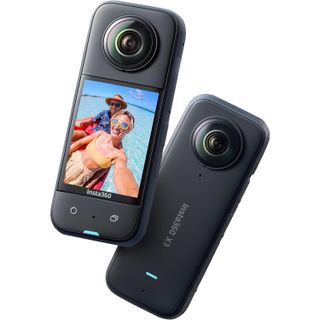
The best 360 degree camera overall
With incredibly 5.7K 360 degree footage, Active HDR for retaining highlights, and great image stabilization, there is no better choice.
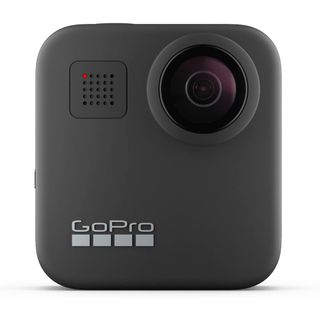
The best 360 degree camera for stabilization
GoPro's superior HyperSmooth stabilization works a treat when capturing fast moving action such as sports and outdoor escapades.

The best 360 degree camera for 8K
Dual 20MP CMOS sensors are paired together to capture incredible 8K video at 30fps and 4K video at up to 200fps. Best in class for resolution.

The best 360 degree camera for 3D VR
Thanks to its hinged design, the Insta360 Evo can capture 3D VR content across an 180 degree field of view. A perfect solution when paired with a VR headset.

The best modular 360 degree camera
Comprised of three individual blocks, the Insta360 One R enables the separation of the battery, controls and the camera itself.

The best waterproof 360 degree camera
With waterproof capabilities down to 5m (16') this is a great option if you're regularly shooting around water.
The best 360 degree cameras for 2024
Why you can trust TechRadar
Below you'll find full write-ups for each of the best 360 degree cameras in our list. We've tested each one extensively, so you can be sure that our recommendations can be trusted.
The best 360 degree camera overall
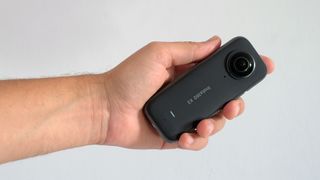
Specifications
Reasons to buy
Reasons to avoid
✅ You want a big screen: With a 2.29-inch touchscreen you'll be able to interact with menus and footage easily.
✅ You need high dynamic range: Active HDR mode works its magic at ensuring that all the necessary detail is retained in the highlights and shadows.
❌ You want natural footage: A times, the camera over processes footage and results in an overly synthetic look.
❌ You need ultra-sharpness: 4K videos do appear a little soft which means a lack of overall clarity.
An upgrade to our previous favorite, the Insta360 X3 takes everything great about its predecessor and amps it up a notch. Pocket-friendly yet powerful, it beats the GoPro Max for single-lens 4K clarity, and excels when it comes to shooting 5.7K 360-degree footage. While some processing elements can appear more synthetic than a GoPro, we found its Active HDR mode was brilliant at retaining detail in highlights. The continued effectiveness of FlowState image stabilization also impressed in testing.
We felt its significantly larger 2.29-inch touchscreen made the Insta360 X3 a much easier camera to use handheld, even if there remain a few software quirks to be ironed out. Once you’re familiar with the interface, though, it’s largely a breeze. Insta360’s editing workflow also proved seamless in testing, with diverse and intuitive tools complementing the experience. Our review time revealed the claimed 81-minute battery life to be realistic, too. Add in 10m water resistance – twice that of the GoPro Max – and the Insta360 wins out as the most versatile 360 camera you can buy right now.
Read our in-depth Insta360 X3 review
The best 360 degree camera for stabilization
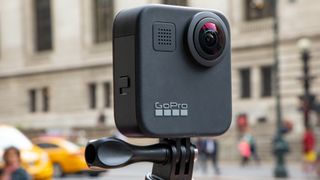
Specifications
Reasons to buy
Reasons to avoid
✅ You want video reframing: Editing and reframing tools in the GoPro smartphone app makes it possible to crop footage after shooting.
✅ You need image stabilization: Fast moving action can be stabilized with great in-camera technology.
❌ You are shooting in low-light: The sensor size and technology results in a disappointing level of noise in the shadows.
❌ You need shooting mode variety: The lack of shooting modes is a real limitation that restricts the type of footage that can be captured.
If you're looking to shoot immersive videos of sporting escapades or outdoor adventures, then the GoPro Max is a good alternative to the Insta360 One X2 close. It's waterproof down to five meters without needing a case, and the editing workflow is slick and simple. If you want to turn your 360-degree video into a traditional 2D film – which is one of the main benefits of 360 cams – the app's OverCapture software lets you do this easily, as long as your happy with the final footage being in Full HD.
The Max also amps up many of the features seen on the GoPro's Hero action cams, including superior HyperSmooth stabilization and 360-degree TimeWarp sequences. The slightly sub-par 2D video footage (which is the result of it being converted from a fish-eye images) means the Max falls short of being the ultimate GoPro for both 360 and standard footage. But it's a fantastic option for anyone who wants to shoot action sequences in every direction without the hassle of deciding where to point their action camera, then edit it together quickly later.
Read our in-depth GoPro Max review
The best 360 degree camera for 8k

Specifications
Reasons to buy
Reasons to avoid
✅ You need high resolution: 8K capabilities allow for maximum flexibility when cropping shots.
✅ You want great slow-mo: Footage can be captured at 120fps using 4K to allow for footage to be slowed down.
❌ You need waterproofing: You'll need to keep this 360 degree camera well away from water.
❌ You want lightweight: At 9.7 oz / 275 g this is far from the lightest option available.
Numbers never tell the whole story, but 8K is a seriously impressive figure in a consumer 360 camera's spec sheet. Qoocam’s 360 heavyweight outguns all of the competition on resolution, with a pair of 20MP CMOS sensors that work together to capture 8K footage at 30fps and 4K video at up to 200fps.
Not only can it create VR-grade video out of the box, but it’s also the first non-pro model from which 360 footage can be cropped down to widescreen format without a big drop in resolution. It packs impressive SuperSteady image stabilization, too, as well as a class-leading 2.4-inch OLED touchscreen for easy control and framing. For both stills and video, dynamic range is excellent, as is color and contrast.
Downsides? There are limited video modes and the partner app is pretty basic, though there’s a handy express mode which downscales footage for mobile editing. There’s also no escaping the relative heft of the Qoocam 8K, or its lack of waterproofing. All the same, provided you can stomach its price tag, its video quality is unrivaled in the 360 market. Once you try 8K, there’s no going back.
Read our in-depth Kandao QooCam 8K review
The best 360 degree camera for 3d vr
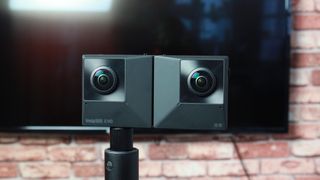
4. Insta360 Evo
Specifications
Reasons to buy
Reasons to avoid
✅ You want 3D VR footage: Side-by-side cameras capture VR footage that can be viewed with a VR headset.
✅ You need high dynamic range: Low light performance is far from ideal due to the noise levels.
❌ You want elegant design: With average build quality and larger format this isn't very pocket friendly.
❌ Additional headset required: If you want to view 3D VR footage then you'll also need a VR headset.
It might not have the elegant, pocket-friendly design of Insta360’s One X, but the Evo is a more flexible form of 360-degree camera. One minute it can function as a standard 360-degree camera with back-to-back fisheye lenses, capturing everything around it in decent 5.7K resolution. The next moment, thanks to its hinged design, both lenses will be sitting side by side facing the same direction, allowing them to capture 3D VR content with a 180-degree field-of-view. You’ll really need an Oculus or similar VR headset to appreciate the latter, however – and for most people the One X probably makes more sense.
FlowState Stabilization keeps video shake-free, enabling users to capture footage that’s both smooth and steady. The Insta360 Evo also benefits from high dynamic range capabilities, which make it ideal for shooting scenes that have extreme highlights and shadows. To top it all off, you can create cinematic sequences by slowing down or speeding up footage, all in the Insta360 app.
The best modular 360 degree camera
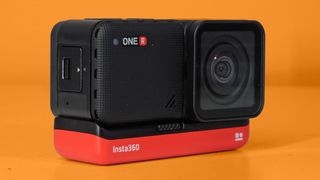
Specifications
Reasons to buy
Reasons to avoid
✅ You want swappable lenses: The modular design allows for both 360 degree shooting as well as 4K wide angle filming.
✅ You want great detail: Image processing results in sharp images, especially during ideal lighting conditions.
❌ You need faultless stitching: Slight abnormalities can occur if your crop covers the border between sources.
❌ You want a big screen: The 1.3-inch square display really limits the viewing of footage and navigating menus.
The headline feature of the Insta360 One R is its modular design. Comprised of three blocks – battery, controls and camera – the lens section can be switched to suit your situation. Besides a 1-inch sensor module, the dual-lens element is seriously exciting: capable of capturing 360-degree footage in 5.7K at 30fps, it transforms the Insta360 One R from action cam to capable 360 cam. Stabilization is excellent, as is the stitching, with only a slight flutter if your crop covers the border between sources. Like the GoPro Max, sharpness drops at the edge of each lens, but results in bright conditions are good, with decent detail and limited noise.
The same can’t be said in low light, where software processing issues arise, with lots of juddering and blurred frames. Editing 360-degree video means selecting and dragging one of five fields of view in the app, which is slightly limiting but ultimately quick, while optional subject-tracking delivers a professional look with minimal effort. It's not quite as slick as the GoPro Max, but it's cheaper, offers a unique modular approach and delivers solid 360-degree footage. With a few software fixes, the Insta360 One R could be a real 360 success.
Read our in-depth Insta360 One R review
The best waterproof 360 degree camera
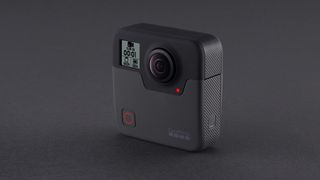
Specifications
Reasons to buy
Reasons to avoid
✅ You want durability: The rubber casing provides a durable design that is ideal for knocks and scapes.
✅ You want a waterproof solution: At 5m you'll be able to use this 360 degree camera even when there's water around.
❌ You need to live stream: With nothing to support this you'll need to look elsewhere.
❌ You want fast processing: Downloading of video takes an age and really removes the joy out of the creative process.
GoPro’s highly innovative camera has enjoyed a significant price drop since its launch, making it worth considering if you can't stretch to the newer GoPro Max. The Fusion can capture 360-degree video in 5.2K resolution at 30fps (or 3K at 60fps) which is great, but its real trick was the introduction of the OverCapture mode. Like the GoPro Max and Insta360 One X, this lets you film in 360 degrees then create a standard 16:9 video from the footage.
Add GPS, a compass, accelerometer, gyroscope, Wi-Fi, Bluetooth, 3D audio, and compatibility with existing GoPro mounts, and the waterproof (to a depth of 5m) Fusion is a powerful camera for the price. The newer GoPro Max brings a front-facing screen, a more compact design, six microphones (rather than four) and better image stabilization. The Fusion's last software update was also over a year ago, if these issues don't bother you then it's definitely worth considering if you need a waterproof 360-degree camera.
Read our in-depth GoPro Fusion review

How to choose
How do I choose the best 360 degree camera?
The best 360 cameras come in a range of shapes, sizes and styles. That said, most models work in a similar way: they use multiple camera modules (usually two wide-angle lenses placed back-to-back) to capture footage which can then be digitally combined to create a fully spherical video.
But there are also plenty of differences between the 360 cameras in the list above. Many 360 cameras include features such as automatic stitching (which saves you the hassle of manually aligning multiple captures) and image stabilization for steady shots. The top options, including the Insta360 One X2 and GoPro Max, can also use software trickery to digitally erase compatible hand grips from the frame, so you can record yourself without a big boom arm blocking your shot.
Resolution varies from camera to camera. The highest resolution consumer 360 camera in 2021 is the Kandao QooCam 8K, which can shoot 360 video at 8K. More affordable options like the GoPro Max and Insta360 One X2 shoot at 5.6K and 5.7K resolutions respectively. But it’s important to remember that those numbers refer to the full 360 resolution; if you crop down to a flat frame, the resolution will be much lower (normally 1080p or less).
This cropping functionality allows you to extract a standard ‘flat’ video from the 360-degree footage. This means you can shoot everything that’s going on around you, then select an area of focus when you’re back home. This is particularly useful for fast-moving and unpredictable subjects, such as safari animals or extreme sports enthusiasts.
The relevance of other features, such as GPS, Wi-Fi and slow-mo modes, will depend on what and how you like to record. Many of the best 360 cameras feature creative shooting tools and handy connectivity features, plus smartphone apps which make editing and sharing easier.
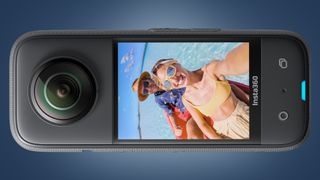
What’s the best 360 camera for virtual tours?
360 cameras are a great choice for shooting immersive virtual tours. Upload 360 images or video to a compatible hosting platform (such as Facebook or CloudPano) and visitors will be able to explore a location in full 360 degrees from the comfort of their home. This is particularly useful for venues such as a hotels and museums, as well as real estate listings.
The right 360 camera for your virtual tour will depend primarily on whether you plan to shoot a video tour or a static photo tour.
It’s possible to create a virtual tour simply by walking around a location while recording video. If this will be your approach, any of the top cameras in the list above should produce smooth, sharp 360-degree footage. The Kandao QooCam 8K in particular can capture detailed 8K video and benefits from SuperSteady stabilization smarts (although file sizes for 8K video are much larger and may be compressed by certain platforms).
Most virtual tours use 360-degree stills shot by a tripod-mounted camera. The best 360 cameras in 2021 can capture sharp, immersive images which are perfect for virtual tours. The Kandao QooCam 8K is again a great option here: it shoots dynamic still images at a resolution of 29.4MP (the highest of any camera in our list), allowing viewers to pan around sharp virtual scenes. It also features a tripod mount on its base for easy positioning.
If you’re looking for a less expensive option, our favorite 360 camera – the Insta360 X3 – is an affordable way to shoot 360 stills for virtual tours. It also features a tripod mount and captures 360 stills at a respectable 18MP.
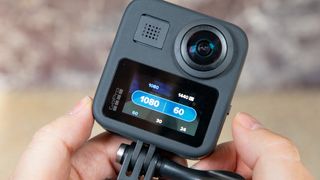
How we test 360 degree cameras
Our reviews are always hands on and actively compare cameras to previous versions or alternative models. We look at various elements, including design, features, performance, and image and video quality.
First up is the camera's design. During this step, we're wanting to get an idea of how the camera handles. Is it small or big, light or heavy, and is that positive or negative for the target audience? We'll put the user interface through its paces and decide how user-friendly and intuitive the workflows are. All of this will be done utilising the built-in touchscreen, which will be assessed for size, quality, and responsiveness.
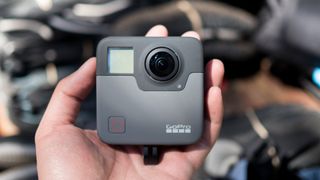
360 degree cameras are well known for having various modes and feature sets that complement the core 360 degree filming functionality. We test all of these features to see how good they are and whether they are usable in a production context. While doing this, we'll use a formatted SD card to capture both video and photos to enable us to comment on the performance as it relates to quality, low-light performance, and battery life.
These types of cameras rely heavily on the use of a companion app, which we also download and test. If the app unlocks specific features or enables a live-feed view, then we'll comment on that too.
After all our testing is complete, we take everything we've learned about the camera and factor in its price to get a sense of the value-for-money it offers before reaching our final verdict.
Get daily insight, inspiration and deals in your inbox
Get the hottest deals available in your inbox plus news, reviews, opinion, analysis and more from the TechRadar team.

Tim is the Cameras editor at TechRadar. He has enjoyed more than 15 years in the photo video industry with most of those in the world of tech journalism. During his time as Deputy Technical Editor with Amateur Photographer, as a freelancer and consequently editor at Tech Radar, Tim has developed a deeply technical knowledge and practical experience with cameras, educating others through news, reviews and features. He’s also worked in video production for Studio 44 with clients including Canon, and volunteers his spare time to consult a non-profit, diverse stories team based in Nairobi. Tim is curious, a keen creative, avid footballer and runner, and moderate flat white drinker who has lived in Kenya and believes we have much to enjoy and learn from each other.
- Paul HattonFreelance writer
